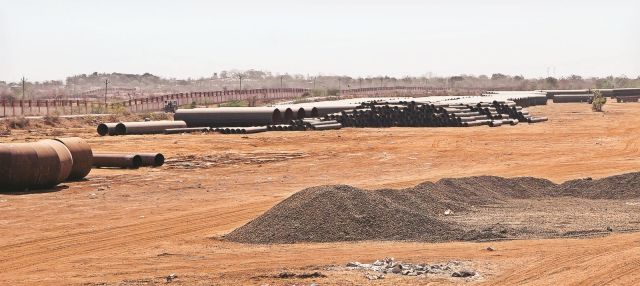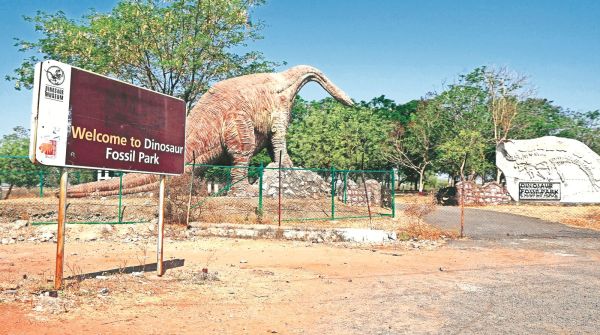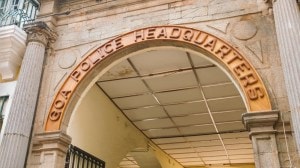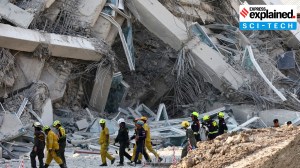Gujarat Hardlook: Too close for comfort? Multi-crore irrigation project near Dino Land triggers concern
Home to the Dinosaur Fossil Park and Museum, Rayoli, a quaint village in Gujarat's Mahisagar, holds a crucial key to prehistoric life on the planet. Now, an irrigation project aimed at benefitting 125 villages is underway near the site. How will this affect what is said to be one of the largest hatcheries of dinosaur eggs in the world?
 A boundary wall separates the fossil park and the project. Trenches have been dug for the lift irrigation project worth Rs 585-crore that will supply water to 125 villages in Kheda and Mahisagar . (Express photo/Bhupendra Rana)
A boundary wall separates the fossil park and the project. Trenches have been dug for the lift irrigation project worth Rs 585-crore that will supply water to 125 villages in Kheda and Mahisagar . (Express photo/Bhupendra Rana)Close to the recently-finished boundary wall ‘protecting’ the 72-hectare land of the Forest Department that houses the Dinosaur Fossil Park in Raiyoli of Mahisagar district’s Balasinor taluka, deep and wide trenches have been dug up for a lift-irrigation project worth Rs 585 crore that will supply water to 125 villages in Kheda and Mahisagar districts.
A part of the Lameta formation, the fossils date back to the Late Cretaceous period of the Mesozoic era, going back 67 million years, when the large bipedal carnivorous theropod dinosaurs — later christened Rajasaurus Narmadensis and Rahiolisaurus Gujaratensis — walked on the land that is now a crest of the majestic natural fossils. This evidence of prehistoric life on the planet, engraved in the rocks against the striking countryside of Balasinor, is considered to be one of the largest hatcheries of dinosaur eggs in the world, along with Aix-en-Provence in France, and Mongolia.
The GSI discovered a rich collection of dinosaur bones and egg hatcheries with around 100 eggs and other remains at Raiyoli in Balasinor in present-day Mahisagar district (formerly part of Kheda district) in 1981-82. The land, where the present-day fossil park stands, was declared a reserved forest area in February 1975. Considering the importance of the site, the GSI, in 1988, had proposed the preservation of the area as Dinosaur Fossil Park, recommended protection and development by undertaking fencing, preservation of the fossils, research on dinosaurs, development of a museum, on-site lab, model park and so on. Paleontologists, however, feel the fossil sites in Gujarat are under excavated due to “lack of interest”.
Currently, a small part of the 72 hectare park has about 15 enclosures of naturally embedded fossil exhibits on display that have been identified over the last four decades. Paleontologist and emeritus professor at Panjab University, Chandigarh, Ashok Sahni, who set up the Dinosaur of India Gallery in that city, tells The Indian Express, “The GSI excavation happened in the early 1980s and then there was another excavation in the 1990s when a group of paleontologists, led by Sankar Chatterjee from the Texas Tech University and the Indian Statistical Institute (ISI), which has a geological study unit, excavated a part of it with permission from GSI. They found a number of things but never published anything and nothing is known…”
“As far as the GSI is concerned, they have not done anything since the early 1980s. If anybody, involved with science, says that everything has been done and nothing further can be done, they do not know what they are saying… (In scientific research) the more you do, the more you learn,” Sahni asserts.

 The entrance to the Dinosaur Fossil Park located in Raiyoli of Balasinor taluka Express photo/Bhupendra Rana
The entrance to the Dinosaur Fossil Park located in Raiyoli of Balasinor taluka Express photo/Bhupendra Rana
Sahni adds that it was only in 2001 when experts from a team of Indo-US researchers, funded by the National Geographic, of which Sahni was a part, named the Rajasaurus Narmadensis. Later, in 2010, experts also described the second species, Rahiolisaurus Gujaratensis, although the excavations were carried out between 1995 and 1997 by Chatterjee and ISI.
GSI deputy director general Sudhangsu Dutta told The Indian Express that the excavations at the site to discover, document, and create scientific models were complete. “Whatever species we expect over there and in India also, have been discovered… If you get some indication, then only you can go further… Here we have got only the same type of fossils…”
Dutta added that although the paleontology division last year discovered one more species of dinosaur from Rajasthan’s Jaisalmer, the past studies around Raiyoli have not indicated the presence of any new species.
Dutta stated that with the government push and focus on exploration on minerals, there is no sufficient manpower to continue fossil excavations at identified sites.
“We periodically visit Balasinor to conduct programmes. We are also working on increasing the visibility of the national geo heritage sites, of which Raiyoli fossil park is already a part… The GSI works in mission mode… Environmental studies come under Mission 4 and the Government of India is laying more emphasis on critical minerals and mineral exploration that forms part of Mission 2. We are carrying out geo tourism projects for paleontology,” Dutta said.
‘Lack of planning, monitoring’
In its 2014-15 report on the Economic Sector for Gujarat, the Comptroller and Auditor General (CAG) of India had pointed out that “lack of planning and monitoring” of the Dinosaur Park (was) leading to “non-fulfillment of the envisaged goals… after the lapse of 33 years from the discovery of the site in 1981.” According to CAG, a meeting in 1998 chaired by the Commissioner of Geology and Mines, had decided that the Forest Department would be implementing agency for protection and development of the area.
The CAG report stated, “The GSI recommended in 1997, the excavation of sites and its survey to collect more fossils as it has a great potential because many fossils in partly exposed positions were also found. However, excavation was not carried out… Even the survey of the site for collecting scattered parts, their proper removal and conservation was not done (until June 2014). Thus, the prized heritage was left (open) to possible damage due to human vandalism and theft.”
The CAG had observed that the department did not have an inventory of the “various fossils (buried/ half-exposed/ loose) lying at the site and no photo-documentation of fossils was prepared since their discovery. Hence, nothing could be known about the parts of fossils taken away by researchers for study and/ or theft by common people etc…”
The report blamed the Forest Department for “not having framed guidelines for protection” of these fossils at the time of opening of the site for public viewing and even recommended that the department deploy guides for “educating the visitors of the unique heritage”.
The auditor had also recommended helping recognise the site as a “UNESCO world heritage site”, which the GSI said it is doing now. “The GSI, for the purpose of recommending the site for Geopark, requested TCGL (Tourism Corporation of Gujarat) and GEER (Gujarat Ecological Education and Research) Foundation to provide certain details for which response was awaited. Also, no action was taken by the State Government to propose this site as a World Heritage Site,” the CAG report observed in 2015.
Damage vs development
Dutta does not feel that the upcoming pipeline project in the periphery of the park will damage the fossils. “Beyond the boundary area, where fossils are not yet identified, it (the park) has to give up for the betterment for development work… That will not harm the site as a whole in the protected forest area… Within the forest boundary, where we have identified or kept the fossils in the field, a big area is still left and we have that space for exploration. We have to get permission from the Forest (Department) before we can do any excavation there.”
Dutta adds that although the fossil park attracts tourists, the department is making efforts for its promotion among the three national geological sites in Gujarat — along with Eddy Current markings in Kadana in Mahisagar and the Rann of Kutch, which also include the wood fossils in ASI-protected site of Dholavira. According to the GSI website, “The Eddy current markings are believed to result from dragging of a small limb of a larger floating log caught in a vortex or Eddy current of a stream or from a movement of a pebble. The petrified marks of the eddies around the whirl balls form spiral ribs.” The website lists the Kadana Eddy current markings as a site of GeoTourism in the country.
Treasure trove of fossils
Experts point out several instances across the world when infrastructure projects have unearthed a treasure trove of fossils in unknown areas. In 2020, precious fossils were found in Auckland in New Zealand when a wastewater company began digging a site. While a majority of the fossils found included baleen whale vertebrae, sharks’ teeth, rare specimens of coral, and bones from eagle rays, in 2013, a 10-metre long fossilised dinosaur was found by a crew of workmen that cleared open land to lay pipelines in south west of Spirit River in Canada’s Alberta.
Similar discoveries of dinosaur bones were also made at Highland Ranch in Colorado in May 2019 by construction workers — later identified as belonging to a large adult triceratop.
On what could have been done, Sahni suggests that before the pipeline project, “they would have asked the GSI to do some excavations along the length of the pipeline project to see whether there was anything of importance or not”. “That is what would happen in most countries, where they are aware how important fossils are. It does not happen here because someone else is in-charge of the pipes, while another is in-charge of the fossils…”, says the paleontologist.
Sahni says that he has recommended to government committees that they must undertake regular excavations at the site. “For a young child, the interest is to be able to see how they appear in the rocks, how they are found, cleaned. They have set up a fence around the Raiyoli park but what are they preserving? If nothing is coming out and they think there is nothing there, why are they preserving it? On the contrary, Bagh in Madhya Pradesh’s Dhar has managed to preserve everything in-situ despite similar problems it has,” he adds.
From obscurity to spotlight
Aaliya Sultana Babi, princess of the erstwhile Balasinor state, who is a member of the current government committees on the fossil park, has been involved in advocating for the conservation of the site since 1996. She told this paper, “Raiyoli was an obscure little village no one knew about. It has given three dinosaurs to the world. The area has also given the Sanajeh Indicus fossil to the world showing a snake eating a dinosaur hatchling… It also has a unique museum attached to the excavation site… I feel that this area has a lot of potential if excavation is carried out by the agencies. There are fossils and eggs in the 72 hectares and also in the outside area. It is understandable that for the government too, it is not possible to barricade every area… But a new species can be discovered for sure.”
Aaliya feels that bringing the government departments on one platform will help develop the site into a global destination for dinosaur studies. “Everyone has to come on a single platform… The departments must come together and do the excavation. We do get tourists, paleontologists and students of paleontology who have a lot of interest in the area. The land belongs to the forest (department) so necessary permissions have to be given by them… Of course, it deserves to be a UNESCO- declared World Heritage Site… If it does become one, there will be no looking back.”
Project not damaging fossil site, says govt
Mahisagar administration officials said the upcoming project will resolve “irrigation deficiencies” in about 8,100 hectares of land. An official, requesting anonymity, said, “The project, in implementation since June 2024, aims to channel the water of Mahi River into over 130 ponds in Mahisagar and Kheda districts. The Narmada Water Resources, Water Supply and Kalpsar Division has undertaken the project of lift irrigation, aimed at supplying water from the upstream side of Wanakbori weir of Mahi River. It will irrigate villages in Balasinor Taluka of Mahisagar district as well as Kapadvanj, Kathlal, Galteshwar, and Thasra in Kheda district. A 40-lakh litre water tank is also commissioned for Raiyoli and the deadline for the entire project is 2027…”
The official said, “The project is a crucial one for addressing the water crisis in Central Gujarat and it has been planned along the periphery of the fossil park. At no point does the project pass through the fossil site or cause any damage to the protected site… As far as the likelihood of fossils under the earth of the pipeline area is concerned, it has not been identified and is not a protected land yet… Development projects to meet the needs with advancing years are a must”. “Had the departments concerned excavated the site earlier or requested that they want to examine the site before the project is implemented, the government would have definitely considered. If experts have not raised the issue, then the project may not be coming in the way of their interests,” the official added.
Meanwhile, officials of the Forest Department say that the irrigation project is not coming up on land which is under the forest jurisdiction. Conservator of Forests, Vadodara Circle, Anshuman Sharma told The Indian Express, “We have not received any proposal from the GSI or any other department concerned to carry out any excavations in the reserved forest area that houses the fossils. The boundary wall was built from a grant of the Tourism Department about two years ago, when it had also sought permission for building some tourist amenities including a pathway. We have deployed four temporary staff, who are locals and also guide tourists when needed”.
“In any case, any department that intends to do any non-forest activity on the land will have to seek permission as per the provisions of the Forest Conservation Act to implement the same. However, if there is any help that the Forest Department can extend to any department concerned to get a UNESCO heritage site tag for the fossil park, we would be more than happy to do so, under the purview of the forest laws,” said Sharma.
Must Read
Buzzing Now


Mar 29: Latest News
- 01
- 02
- 03
- 04
- 05























